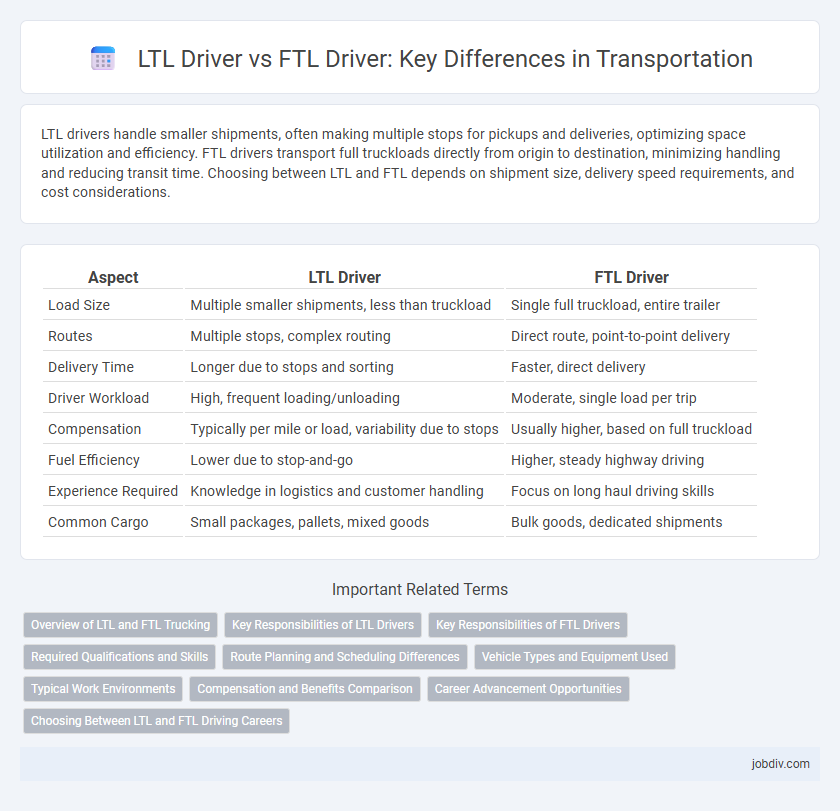LTL drivers handle smaller shipments, often making multiple stops for pickups and deliveries, optimizing space utilization and efficiency. FTL drivers transport full truckloads directly from origin to destination, minimizing handling and reducing transit time. Choosing between LTL and FTL depends on shipment size, delivery speed requirements, and cost considerations.
Table of Comparison
| Aspect | LTL Driver | FTL Driver |
|---|---|---|
| Load Size | Multiple smaller shipments, less than truckload | Single full truckload, entire trailer |
| Routes | Multiple stops, complex routing | Direct route, point-to-point delivery |
| Delivery Time | Longer due to stops and sorting | Faster, direct delivery |
| Driver Workload | High, frequent loading/unloading | Moderate, single load per trip |
| Compensation | Typically per mile or load, variability due to stops | Usually higher, based on full truckload |
| Fuel Efficiency | Lower due to stop-and-go | Higher, steady highway driving |
| Experience Required | Knowledge in logistics and customer handling | Focus on long haul driving skills |
| Common Cargo | Small packages, pallets, mixed goods | Bulk goods, dedicated shipments |
Overview of LTL and FTL Trucking
Less-Than-Truckload (LTL) trucking involves transporting smaller freight loads from multiple customers, optimizing cost-efficiency by consolidating shipments in a single truck. Full Truckload (FTL) trucking caters to large shipments that require the entire truck space, offering faster transit times and direct routes without intermediate stops. LTL drivers manage multiple deliveries and pickups per trip, while FTL drivers focus on point-to-point transportation with larger cargo volumes.
Key Responsibilities of LTL Drivers
LTL drivers handle smaller freight shipments by consolidating multiple loads from different customers, requiring precise route planning and efficient load management to optimize delivery schedules. They are responsible for ensuring accurate paperwork, timely pickups, and deliveries within tight time windows, often navigating frequent stops at various locations. Safety compliance, vehicle inspection, and maintaining communication with dispatchers are critical to managing complex, multi-stop routes typical in Less Than Truckload transportation.
Key Responsibilities of FTL Drivers
FTL drivers are responsible for transporting full truckloads of freight directly from the shipper to the consignee, ensuring timely and safe delivery. They manage logistics related to route planning, vehicle maintenance, and cargo security to optimize efficiency and reduce transit times. FTL drivers must comply with federal and state regulations, complete detailed documentation, and maintain communication with dispatch and clients throughout the delivery process.
Required Qualifications and Skills
LTL drivers must have strong route planning abilities and experience in handling multiple deliveries with varying cargo, requiring excellent organizational and time-management skills. FTL drivers need a commercial driver's license (CDL) with endorsements for hazardous materials or oversized loads, demonstrating proficiency in long-distance driving and vehicle maintenance. Both roles demand safety compliance, physical stamina, and effective communication skills to ensure timely and secure transportation of goods.
Route Planning and Scheduling Differences
LTL drivers manage multiple stops with complex route planning to optimize load consolidation and minimize mileage, requiring precise scheduling to accommodate varying delivery windows. FTL drivers typically follow direct, point-to-point routes which simplify scheduling but demand efficient time management for long-haul trips. The key distinction lies in LTL's dynamic multi-stop coordination versus FTL's streamlined, single-destination scheduling.
Vehicle Types and Equipment Used
LTL drivers typically operate smaller vehicles such as box trucks, straight trucks, or multi-stop vans designed for multiple deliveries and quick loading and unloading, often equipped with lift gates or hand trucks. FTL drivers use larger tractor-trailers or semi-trucks designed for long-haul shipments, featuring a sleeper cab for extended trips and advanced GPS tracking systems. Vehicle choice and equipment reflect the distinct logistics needs, with LTL emphasizing efficiency in handling varied cargo volumes, while FTL focuses on transporting full trailers over long distances.
Typical Work Environments
LTL drivers typically operate in urban and regional routes, handling multiple stops at distribution centers, warehouses, and retail locations, which demands frequent loading and unloading of smaller freight loads. FTL drivers usually travel long distances on highways with a single, full truckload, providing direct point-to-point deliveries that require extended periods on the road with minimal stops. Both roles demand strong navigation skills, but LTL drivers experience more variable schedules and work environments compared to the more consistent, long-haul routes of FTL drivers.
Compensation and Benefits Comparison
LTL drivers typically earn lower base pay compared to FTL drivers due to shorter routes and more frequent stops, averaging $45,000 to $60,000 annually, while FTL drivers can earn between $55,000 and $75,000 per year. Benefits for FTL drivers often include higher mileage bonuses, more comprehensive health plans, and enhanced retirement options, reflecting the longer trips and increased responsibility. LTL drivers benefit from more consistent home time and may receive incentives for efficient delivery schedules, balancing compensation with quality-of-life considerations.
Career Advancement Opportunities
LTL drivers often gain diverse experience by handling multiple stops and load types, which can enhance skills valuable for management or dispatch roles. FTL drivers typically focus on long-haul routes with consistent cargo, offering opportunities to specialize in logistics planning or fleet management. Both career paths provide advancement options, but LTL drivers may benefit from broader operational knowledge while FTL drivers can leverage expertise in route optimization and driver mentorship.
Choosing Between LTL and FTL Driving Careers
Choosing between LTL and FTL driving careers depends largely on preferences for route variety and cargo handling. LTL drivers manage multiple shorter pickups and deliveries daily, requiring strong organizational skills and frequent customer interactions, while FTL drivers typically handle one dedicated shipment over longer distances, favoring those who prefer extended solo driving and fewer stops. Factors such as work-life balance, pay structures, and company benefits also influence the decision in the transportation industry.
LTL Driver vs FTL Driver Infographic

 jobdiv.com
jobdiv.com